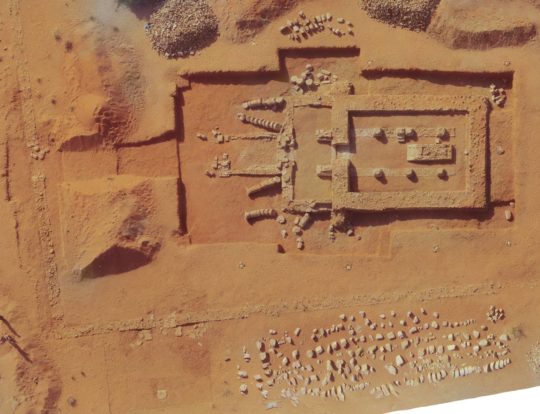08.09.2018
Naga at the Conference for Nubian Studies in Paris
Naga at the Conference for Nubian Studies in Paris
The 14th International Conference for Nubian Studies, co-hosted by the Musée du Louvre and the Sorbonne Université, took place in Paris from September 10th to 15th 2018. The Naga Project was presented in three lectures.
In “Naga – a Compendium of Meroitic Sculpture”, Professor Wildung presented the rich corpus of sculpture that has come to light since the beginning of the Naga excavations and announced the first volume in the newly-founded series Archäologie im Sudan (ArS). From 1995 onwards, the Naga Project was able to increase the known corpus of statues from the Meroitic Period by several orders of magnitude. This was particularly evident in the number of other lectures throughout the rest of the conference which used Naga was a main point of reference whenever it came to Meroitic art or architecture.
 © Naga-Projekt
© Naga-ProjektIn his lecture “New Structures of Meroitic Temple Architecture. Naga 2016-2018”, Christian Perzlmeier reported on the spectacular finds of the last few excavation seasons: Temple 1200, set on a raised podium and accessed by ramp, has proven to have an unusual floor plan and a unique architectural design without parallel elsewhere. This building is currently in the process of being reconstructed virtually. To do this, the data from structured-light 3-D scans of the individual blocks is currently being analysed and painstakingly fitted together to make a 3-D computer model of the complete temple. Christian Perzlmeier provided some early examples of this work-in-progress.
 © Naga-Projekt
© Naga-ProjektExcavation work on Temple 700 has uncovered yet another temple building. Before of the pylon of this single-room temple are the pedestals and two pairs of feet from monumental statues of the gods Arensnuphis and Sebiumeker. Access to the temple is once more via a ramp, at the foot of which two lion statues were found. The columns from the forecourt lie toppled, with each drum section nicely aligned with other. Inside the temple, pedestals for statues as well as the lower courses of the high altar have survived; as well as fragments from another pair of statues of the same two gods. They originally stood in from of an entrance portal in the eastern wall surrounding the area. There, the team found the respective pedestals and further fragments of the statues. The lecture offered a peek at the ongoing site analysis and the virtual reconstruction of the finds.
 © Naga-Projekt
© Naga-ProjektIn his lecture, Arnulf Schlüter gave a brief summary of the results of the Naga excavations to date and a sneak peek at future campaigns. In the next few years, the Naga team will be concentrating on Meroitic temple architecture. This subject is almost a no-brainer, as in no other Meroitic site have such a large number of different types of temple survived.
In 2019, work will begin on Temple Naga 500 (also known as Temple F). The temple has been dated to Queen Shanakdakhete and is usually considered the oldest temple in Naga. However, recently doubts have been expressed as to the dating as well as in the identification of Queen Shanakdakhete, making work on Temple 500 interesting for historical and chronological reasons. Additionally, the temple has yet another unusual floor plan and special features in its reliefs –promising very interesting results!
Our thanks to the colleagues at the Louvre and the Sorbonne Université for organising the conference and inviting us to Paris.
